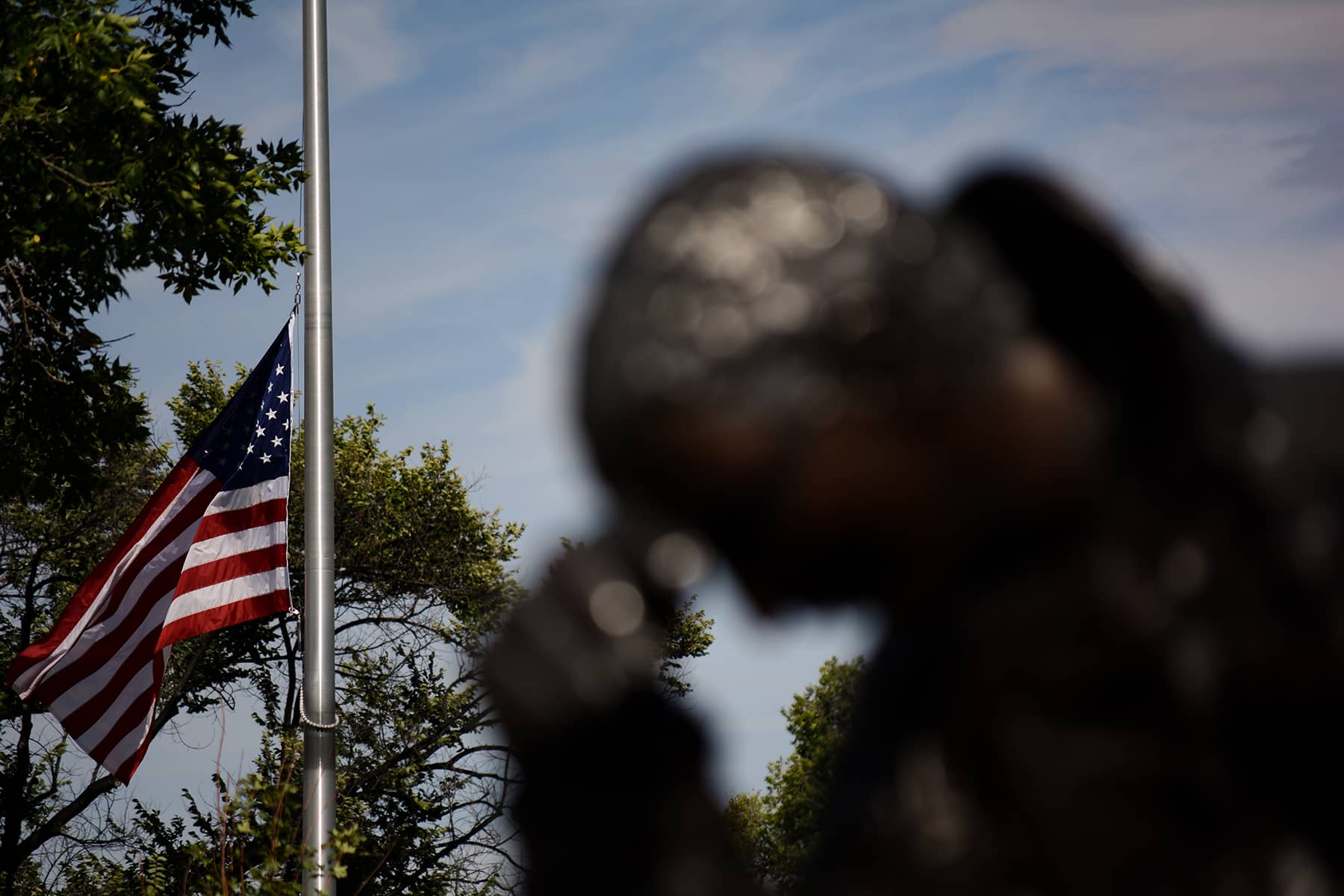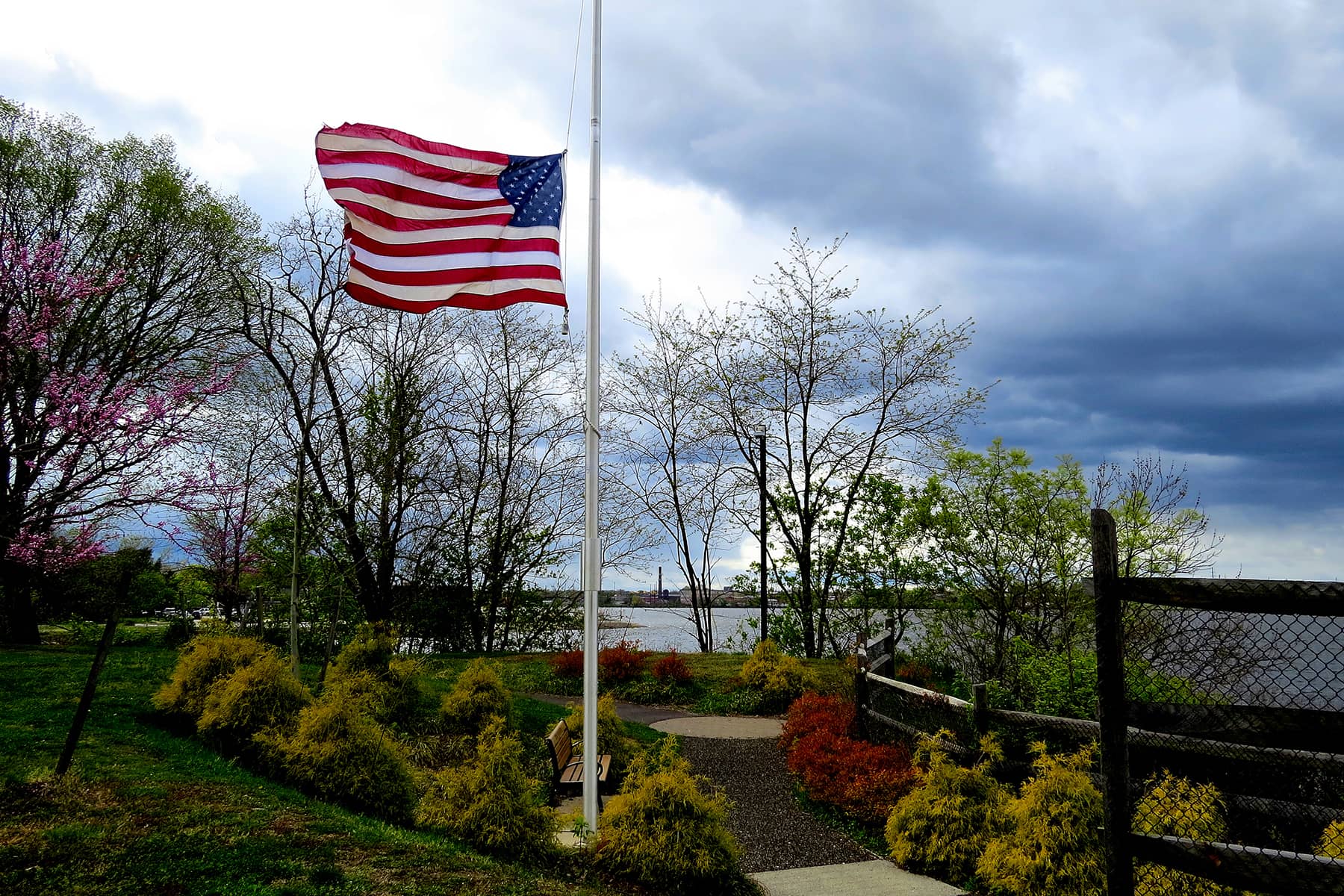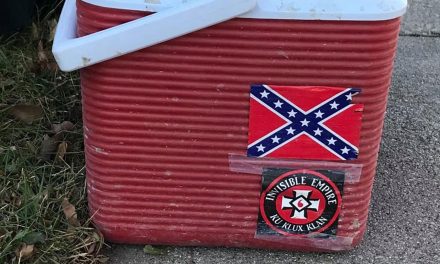
After years of effort, a Waubeka, Wisconsin school teacher successfully lobbied for the 1916 creation of the annual observance of National Flag Day. Every year since on June 14th the United States commemorates its flag as an emblem of the country, a standard for promoting patriotism and activism, and a focal point for national pride in our democracy. Every year since 1966 the United States commemorates “National Flag Week” as Congress so designated: during the week in which June 14 occurs.
The flag commands respect – as a symbol of the Republic’s founding principles of liberty and freedom. The flag also confers respect—as it is hoisted to the peak and lowered to half-staff to honor the deceased who have served under it.
During the last several years, the U.S. and Wisconsin flags were lowered to honor the deceased a record-breaking number of days. In 2021 in Wisconsin, the flags flew at half-staff in silent, solemn salute on 95 days—more than a quarter of the year. The sixteen presidential proclamations and thirty-two gubernatorial proclamations in 2021 included sixty-seven more days of lowered flags than in 2020, and almost three times as many days as in 2018 (the year that the previous highest number of days of symbolic mourning were ordered in Wisconsin). Also notable, since 2018 half-staff honors were ordered for a greater diversity of persons and circumstances.
While other traditions of public mourning and honor have waned, the flag tribute has become even more common. Typically, the flag flew at half-staff a few times per year during the 19th and 20th centuries; in recent decades half-staff orders hovered around a couple of dozen per year. However, due to changes in law and authority, and due to broad interpretations of their powers, presidents and governors have long since gone beyond lowering the flag only a few times a year to mark the past public service of deceased government leaders; instead the number of half-staff salutes have surged.
Two phenomena led to the marked increase in flag salutes: changes in civilian laws and changes in military policy priorities. Congressional Acts in 2008 and 2018 permitted gubernatorial half-staff orders for local deceased fallen armed forces members and local first responders, respectively. Presidents and governors expanded interpretation of these laws to also mark moments of immediate national and local grief, such as mass shootings and the Waukesha Christmas Parade tragedy.
Secondarily, an increase in flag salute frequency is due to the success of the mission-driven work of the Defense POW/MIA Accounting Agency (https://www.dpaa.mil/). Established in 2015, this Department of Defense agency has recovered and brought home hundreds of armed forces personnel from past U.S. conflicts, and honored their service with full military burial.
Following presidential orders, Wisconsin lowered its flags in 2021 and 2022 on all five, Congressionally-authorized annual occasions– Peace Officers Memorial Day (May), Memorial Day until noon, Patriot Day and National Day of Service and Remembrance (September 11), National Fallen Firefighters (October but moved to May in 2023), National Pearl Harbor Remembrance Day (December 7).
Additionally in 2021, Wisconsin followed presidential half-staff orders honoring deceased Americans on 58 more days — for a total of sixty-three federally proclaimed days. The federal orders included honoring two United States Capitol Police Officers at the January 6th insurrection (two days), the victims of the US Capitol attack (five days), 500,00 Americans lost to COVID-19 (five days), victims of four specific mass killings (five days each), victims of the terrorist attacks at the Kabul Afghanistan Airport (five days), and the statutorily-proscribed days of mourning for a former vice-president (eight days), a former Cabinet member (five days), a former senator (seven days), and a Congressman (1 day).
Similarly in 2022 Wisconsin followed presidential half-staff orders honoring deceased persons on the five Congressionally-mandated days and on thirty-seven more days — for a total of forty-two federally proclaimed days. The federal orders included honoring, the victims of the mass shootings in Uvalde, Texas and Highland Park, Illinois (five days each), 1,000,000 Americans lost to COVID-19 (five days), England’s Queen Elizabeth II (twelve days), Japan’s former Prime Minister (three days) and the statutorily-proscribed days of mourning for a former Cabinet member (five days) and a Senator (two days).
Since Congressional Acts in 2008 and 2018 state governors’ powers to issue half-staff proclamations have become essentially unlimited. In 2021 Governor Tony Evers issued thirty such orders, adding thirty-two state proclaimed days to the president’s 2021 proclamations. In 2022, the governor issued fifteen half-staff orders, adding seventeen state proclaimed days to the president’s 2022 proclamations.
Governor Evers’ 2021 orders honored two members of the judiciary (one day each), five public servants who died after contracting COVID-19 in the line of duty (one day each), seven first responders (one day each), two Korea War era veterans (one day each), three military members (one day each), one state representative (one day), Hmong-Lao Veterans (one day), Wisconsin Firefighters Memorial Day (one day), Peace Officers Memorial Day (one day), Waukesha Christmas Parade Tragedy victims (four days total) and five World War II soldiers (one day each, although one day overlapped with September 11).
Governor Evers’ 2022 state orders honored a state judge (one day), a former lieutenant governor (one day), four firefighters (one day each), two state senators (one day each), two state representatives (one day each), a United States Postal worker (one day), Hmong-Lao Veterans (one day), Wisconsin Firefighters Memorial Day (one day), Peace Officers Memorial Day (one day), 1st Anniversary of the Waukesha Christmas Parade Tragedy (one day), and the 10th Anniversary of the Oak Creek Sikh Temple tragedy (one day).
NUMBER OF DAYS THE FLAG LOWERED TO HALF-STAFF IN WISCONSIN
- 28 days in 2020
- 95 days in 2021
- 59 days in 2022
In 2023, the president has signed five half-staff orders with a total of seventeen flag-salute days, most of those days due to three mass shootings. Wisconsin’s governor has signed an additional eight such orders thus proclaiming twenty-five days this year to date that Wisconsin’s flags have been lowered in silent salute.
Concerns exist that presidents and governors might use their proclamations as a mean to garner political points or as a show of executive leadership. Others are concerned that the power, meaning and sincerity of half-staff flag salutes might become diluted by becoming too common, even ordinary.
Despite speculations as to any other motivation, when the flag flies at half-staff it does – for that day – focus and unite Americans and Wisconsinites in honoring patriotic and heroic deceased persons for their contributions to the nation’s founding and persistent principles of service, liberty and justice.
Flag Day itself is designed to focus Americans on those same democratic principles that unite us. As President Woodrow proclaimed on the first National Flag Day, our thoughts as patriotic citizens should be redirected away from “forces within and forces without that seemed likely to draw us away from the happy traditions of united purpose and action of which we have been so proud” … and around which the flag rallies its citizens.
THE BACKSTORY
Post Civil War, a movement arose by veterans to protect the hard-fought-for U.S. flag from commercialism and disrespect. In 1885 the first formally recognized Flag Day ceremony was held in Waubeka, Wisconsin at Stony Hill School. Currently the restored schoolhouse is located near the National Flag Day Americanism Center.
President Woodrow Wilson officially proclaimed June 14th as National Flag Day in 1916, commemorating the date in 1777 when the Second Continental Congress adopted the stars and stripes design.
In 1923 the flag-protection movement met in Washington DC for the first National Flag Conference. Participants from over sixty civic and military groups drafted the first code of flag etiquette. Franklin Delano Roosevelt incorporated the code of etiquette when he codified the U.S. Flag Code in 1942. The Code defined the rules for flag display and acts of respect, generally.
Congress originally allowed a limited number of circumstances that the president could order the lowering of the flag to half-staff on land and half-mast on sea. Protocols adopted by President Eisenhower in 1954 gave specificity in limiting the flag-lowering honors. Essentially lowering the flag occurred: 1) until noon on Memorial Day and 2) “upon the death of principal figures of the United States Government and the Governor of a State, territory, or possession, as a mark of respect to their memory…” Specifically the flag is marked at half-staff on land and half-mast at sea for a president (30 days); for a Vice President, U.S. Supreme Court Justice, Speaker of the House of Representatives (10 days); for a Secretary of an executive or military department, a former Vice President, or the Governor of a State, territory, or possession (from date of death to day of internment); and for a Member of Congress (2 days). Eisenhower then added specificity-lacking provisions that the “president could order flags to half-staff in the event of the death of other officials, former officials or foreign dignitaries, or in accordance with recognized customs or practices not inconsistent with law.” 4) U.S. Code Chapter 1 § 7.
Four decades later Congress began to broaden the scope by which presidents, and now governors, may order flags to be flown at half-staff. In 1994, Congress added Peace Officers Memorial Day on May 15th, and created National Pearl Harbor Remembrance Day on December 7th.
In 2001, Congress added Patriot Day on September 11th, and the National Fallen Firefighters Memorial Service to be held the first Sunday in October. After September 11, 2001, a time of terrorism and war led to more frequent orders to fly flags at half-staff. Under a state law Wisconsin in 2011 added Wisconsin Firefighters Memorial Day, observed on Saturday of Fire Prevention Week, and in 2019 added Hmong-Laos Veterans Day on May 14th.
In 2008 Congress authorized governors to issue flag-lowering honors when a member of the Armed Forces dies while serving on active duty. Ten years later the 2018 Honoring Hometown Heroes Act extended the gubernatorial authorization to proclaim the flag should be flown at half-staff to honor local police, firefighters, and emergency responders.
2021 Presidential Half-Staff Proclamations
- Honoring United States Capitol Police Officers Brian D. Sicknick and Howard Liebengood pursuant to the January 6th insurrection on January 10-11.
- As a sign of respect for the service and sacrifice of the victims of the attack at the United States Capitol on January 6, 2021- for 5 days beginning April 2.
- In memory of the more than 500,000 Americans lost to COVID-19, including over six thousand Wisconsinites, for five days beginning February 22.
- As a mark of respect for the U.S. service members and other victims killed in the terrorist attack on August 26, 2021, in Kabul, Afghanistan, for five days beginning August 26.
- For five days each, mass shootings were mourned by half-staff honors including the victims of violence perpetrated on March 16, 2021 in the Atlanta Metropolitan area; on March 22 in Boulder, Colorado; on April 15, 2021 in Indianapolis, Indiana; and in San Jose, California beginning May 26.
- Upon the death and in honor and remembrance of former Vice President Walter Mondale from his death until date of interment for eight days beginning April 20, 2021; of General and former Secretary of State Colin Powell for five days beginning October 18; of former Senator Bob Dole for seven days beginning on December 5; of Congressman Alcee Hastings for one day on April 7, 2021.
2021 Wisconsin Gubernatorial Half-Staff Proclamations
- Hmong-Lao Veterans Day on May 14.
- Peace Officers Memorial Day on May 15.
- Wisconsin Firefighters Memorial Day on October 7.
- Members of the judiciary, former Wisconsin Supreme Court Chief Justice Shirley Abrahamson on January 5, and Judge George S. Curry of Platteville on December 11.
- Former State Representative Ann Hraychuck on June 22.
- Public servants who died after contracting COVID-19 in the line of duty or due to service-related disease Vandenbroek-Kaukauna Firefighter Stephen M. Smith on December 29, Pardeeville firefighter Brandon R. Romo on December 4, Wisconsin Department of Military Affairs security officer Chad P. Christiansen on December 23, Milwaukee Fire Department Battalion Chief Sean Slowey on December 17, and Boscobel firefighter Joshua D. Fedie on June 12.
- First responders retired Town of Peshtigo Fire Department Captain and Wisconsin State Patrol Trooper Bryan G. Peth on December 21, 2021, Poynette-Dekorra Fire Inspector David Jerald Tomlinson on February 12, North Prairie Fire Department Volunteer firefighter Gary E. Berg on October 30, Wisconsin State Patrol Master Trooper Daniel Stainbrook on November 30, and Beloit Officer Daniel J. “Dan” Daly on November 24, North Prairie Volunteer firefighter Gary E. Berg on October 30, Fond du Lac Police Officer Joseph Kurer on September 29.
- Military service personnel Wisconsin Adjutant General Major General Albert H. Wilkening on August 7, Lt. Col. John A. Palese Jr. of West Bend on November 15, and Major General James G. Blaney on June 4.
- The Waukesha Christmas Parade Tragedy victims were honored with a lowered flag on November 22 and were further honored upon gubernatorial-ordered half-staff honors for fatal victims Jackson A. Sparks on December 2 Leanna “Lee” J. Owen on December 3, and Virginia “Ginny” E. Sorenson and Jane D. Kulich on December 4.
- Korean War soldiers: U.S. Air Force Airman 2nd Class Edward J. Miller, who lost his life while serving in the Korean War on July 17, and Army Sgt. 1st Class Nicholas J. Valentine of the United States Army who lost his life in the Korean War on May 25.
- World War II soldiers: Navy Hospital Apprentice 1st Class Keefe R. Connolly, who lost his life in the attack on Pearl Harbor on November 8, Navy Seaman Second Class Arthur R. Thinnes of the United States Navy who lost his life on the Battleship USS Oklahoma during the attack on Pearl Harbor on October 15, Navy Fireman First Class Kenneth E. Doernenburg of the United States Navy who lost his life on the Battleship USS Oklahoma during the attack on Pearl Harbor on September 25, the Barber Brothers – Fireman First Class Malcom J. Barber, Fireman First Class Leroy K. Barber, and Fireman Second Class Randolph H. Barber of the United States Navy – who lost their lives in Pearl Harbor Attack. The Barber brothers were laid to rest with full military honors in New London, Wisconsin on September 11 and were honored during September 10th, 11th, and 12th – one day of which overlapped the presidential Patriot Day Proclamation.
Between 1941 and 1944 World War II soldiers’ unidentified remains were interred at the National Memorial Cemetery of the Pacific in Honolulu, Hawaii. In 2015, the Defense POW/MIA Accounting Agency exhumed the USS Oklahoma Unknowns for scientific analysis and possible identification. The Barber brothers’ remains were identified in June 2021.
2022 Presidential Half-Staff Proclamations
- Upon the Death of and to Honor Senator Harry Reid. Two days beginning January 12.
- Upon the Death of and to Honor Secretary of State Madeleine Korbel Albright, Five days beginning March 27.
- Remembering the 1,000,000 Americans Lost to COVID-19, Five days beginning May 12.
- National Peace Officers Day May 15.
- Honoring the Victims of the Tragedy in Uvalde, Texas, Five days beginning May 24.
- Memorial Day Half Staff from Until Noon, May 30.
- Honoring Victims of the Tragedy in Highland Park, Illinois Five days beginning July 5.
- Upon the Death of and to Honor Abe Shinzo, former Prime Minister of Japan, Three days beginning July 8.
- Honor of Patriot Day, September 11.
- Upon the Death of and to Honor Queen Elizabeth II.
- Twelve days beginning September 8.
- National Fallen Firefighters Memorial Day October 7.
- National Pearl Harbor Remembrance Day December 7.
2021 Wisconsin Gubernatorial Half-Staff Proclamations
- Mark of Respect for Captain Brian Busch of the Mineral Point Fire Department, January 11.
- Mark of Respect for Firefighter James Ludlum of the Mineral Point Fire Department, January 10.
- Mark of Respect for former State Representative Daniel Roy LeMahieu, February 25.
- Mark of Respect for former State Senator Joseph S. Leean, February 11.
- Mark of Respect for Firefighter Robert A. Stevens of the Fremont-Wolf River Fire Department, February 1.
- Mark of Respect for former Lieutenant Governor Margaret Farrow, March 17.
- Memorial Day, May 29.
- In Honor of Hmong-Lao Veterans, May 14.
- Peace Officers Memorial Day, May 20.
- Mark of Respect for former State Representative Sheryl K. Albers-Anders, June 2.
- Mark of Respect for former State Senator Jeffrey Plale, July 25.
- Mark of Respect for the Honorable John P. Roemer, July 13.
- Mark the 10th Anniversary of the Oak Creek Sikh Temple Shooting, August 4.
- Wisconsin Firefighters Memorial Day, October 1, and October 15 Two Days.
- National Fallen Firefighters Memorial Day October 7.
- In Honor of State Day of Service and Remembrance, September 8-11 (three days).
- Mark the First Anniversary of the Waukesha Christmas Parade Tragedy, November 18.
- Mark of Respect for U.S. Postal Worker Aundre Cross, December 21.
- National Pearl Harbor Remembrance Day, December 7.
- (County-wide only) Mark of Respect for Fond du Lac County Executive Allen J. Buechel, March 29.
Hannah Dugan
Keenan Goodson and Stern Shots














